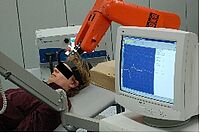Transcranial Magnetic Stimulation (TMS)
Project Description
Aim of the project is to develop a robot assistance system for delivering TMS. Furthermore, we work on a statistical brain mapping procedure to localise muscle representations in the cortex.
The advantages of robotised TMS are manifold:
- Precise targeting of stimulation points.
- Precise tangential orientation of the stimulation coil.
- Simple planning and fast probing of grid-like stimulation patterns.
- Motion compensation keeps coil in place even if the patient moves. A fixation of the head is not necessary any more.
- Repeatability.
For the brain mapping algorithm we combine all three essential pieces of information: The coil positions for stimulation, the corresponding muscle responses, and the characteristic field of the coil used. The main idea is to assume a monotonic functional relation between the electric field strength at the representation point and the evoked muscle response. Using a refined algorithm for Correlation Ratio and Kendall's rank coefficient TAU, we are able to calculate likelihood maps for the representation of specific muscles.

Publications
2015
Microstructure of the superior longitudinal fasciculus predicts stimulation-induced interference with on-line motor control, Neuroimage , vol. accepted for publication, 2015.
2013
Optimal Coil Orientation for Transcranial Magnetic Stimulation, PLoS ONE , vol. 8, no. 4, pp. e60358, 2013.
| DOI: | 10.1371/journal.pone.0060358 |
| File: | journal.pone.0060358 |
Robotized Transcranial Magnetic Stimulation., .... New York: Springer, 2013.
| ISBN: | 978-1-4614-7359-6 |
| File: | 978-1-4614-7359-6 |
Stimulus intensity for hand held and robotic transcranial magnetic stimulation, Brain Stimulation , vol. 6, no. 3, pp. 315-321, 2013.
| DOI: | 10.1016/j.brs.2012.06.002 |
| File: | j.brs.2012.06.002 |
Tracking post-error adaptation in the motor system by transcranial magnetic stimulation, Neuroscience , vol. 250, pp. 342-351, 2013.
| DOI: | 10.1016/j.neuroscience.2013.07.024 |
| File: | j.neuroscience.2013.07.024 |
Design, implementation and evaluation of an independent real-time safety layer for medical robotic systems using a force-torque-acceleration (FTA) sensor, International Journal of Computer Assisted Radiology and Surgery , vol. 8, no. 3, pp. 429-436, 2013.
| DOI: | 10.1007/s11548-012-0791-5 |
| File: | s11548-012-0791-5 |
2012
Roboternavigierte Untersuchung der Tiefenabhängigkeit der Reizstärke bei der transkraniellen Magnetstimulation, Klin Neurophysiol , vol. 43, no. 1, pp. 49-49, 2012.
Variation of Stimulation Intensity in Transcranial Magnetic Stimulation with Depth, Journal of Neuroscience Methods , vol. 211, no. 2, pp. 185-190, 2012.
| DOI: | 10.1016/j.jneumeth.2012.09.007 |
| File: | j.jneumeth.2012.09.007 |
The Effect of Repetitive Transcranial Magnetic Stimulation on Monoamine Outflow in the Accumbens Nucleus Shell in Freely Moving Rats, Neuropharmacology , vol. 63, no. 5, pp. 898-904, 2012.
Safe and clinically applicable robotized Transcranial Magnetic Stimulation, 2012.
Non-orthogonal Tool/Flange and Robot/World Calibration for Realistic Tracking Scenarios, International Journal of Medical Robotics and Computer Assisted Surgery , vol. 8, no. 4, pp. 407-420, 2012.
| DOI: | 10.1002/rcs.1427 |
| File: | rcs.1427 |
Hand-assisted positioning and contact pressure control for motion compensated robotized transcranial magnetic stimulation, Pisa, Italy: Springer Berlin / Heidelberg, 2012. pp. 123-124.
| DOI: | 10.1007/s11548-012-0708-3 |
| File: | s11548-012-0708-3 |
Comparison of stimulus intensity in hand held and robotized motion compensatedtranscranial magnetic stimulation, Neurophysiologie Clinique/Clinical Neurophysiology , vol. 42, no. 1-2, pp. 61-62, 2012.
| DOI: | 10.1016/j.neucli.2011.11.028 |
| File: | j.neucli.2011.11.028 |
Calibration of Force/Torque and Acceleration for an Independent Safety Layer in Medical Robotic Systems, Cureus , vol. 4, no. 9, pp. e59, 2012.
| DOI: | 10.7759/cureus.59 |
| File: | cureus.59 |
2011
IS POST ERROR SLOWING A POST ERROR INHIBITION? A TRANSCRANIAL MAGNETIC STIMULATION APPROACH, Palma, Mallorca, Spain , 2011.
| DOI: | 10.3389/conf.fnhum.2011.207.00385 |
| File: | conf.fnhum.2011.207.00385 |
Navigated and Robotized Transcranial Magnetic Stimulation based on 3D Laser Scans, Lübeck, Germany: Gesellschaft für Informatik (GI), 2011. pp. 164-168.
Realisierung einer schnellen und wiederholbaren Hot-Spot-Bestimmung für die robotergestützte Transkranielle Magnet-stimulation mittels Kraft-Momenten-Steuerung, CURAC, 2011. pp. 31-34.
Robust robot-camera calibration for robotized Transcranial Magnetic Stimulation, International Journal of Medical Robotics and Computer Assisted Surgery , vol. 7, no. 4, pp. 414-422, 2011.
| DOI: | 10.1002/rcs.411 |
| File: | rcs.411 |
Threshold for Transcranial Magnetic Stimulation of the foot: precise control of coil orientation with a robotized system, Klin Neurophysiol , vol. 42, no. 01, pp. P280, 2011.
| DOI: | 10.1055/s-0031-1272727 |
| File: | s-0031-1272727 |
2010
Robot-assisted image-guided transcranial magnetic stimulation for somatotopic mapping of the motor cortex: a clinical pilot study, Acta Neurochirurgica , vol. 152, no. 2, pp. 333-343, 2010.
| DOI: | 10.1007/s00701-009-0565-1 |
| File: | s00701-009-0565-1 |
Towards Direct Head Navigation for robot-guided Transcranial Magnetic Stimulation using 3D Laserscans: Idea, Setup and Feasibility, Armentano, Ricardo and Hudson, Donna and Monzon, Jorge and Patton, Jim, Eds. Buenos Aires, Argentina , 2010. pp. 2283-2286.
| DOI: | 10.1109/IEMBS.2010.5627660 |
| ISBN: | 978-1-4244-4124-2 |
| File: | IEMBS.2010.5627660 |
Simulation of a Conductive Shield Plate for the Focalization of Transcranial Magnetic Stimulation in the Rat, Armentano, Ricardo and Hudson, Donna and Monzon, Jorge and Patton, Jim, Eds. Buenos Aires, Argentina , 2010. pp. 1593-1596.
| ISBN: | 978-1-4244-4124-2 |
Kraft-Momenten-Steuerung für die robotergestützte Transkranielle Magnetstimulation (TMS), 2010.

- Research
- Robotics Laboratory (RobLab)
- OLRIM
- MIRANA
- Robotik auf der digitalen Weide
- KRIBL
- Ultrasound Guided Radiation Therapy
- Digitaler Superzwilling: Projekt TWIN-WIN
- - Finished Projects -
- High-Accuracy Head Tracking
- Neurological Modelling
- Modelling of Cardiac Motion
- Motion Compensation in Radiotherapy
- Navigation and Visualisation in Endovascular Aortic Repair (Nav EVAR)
- Autonome Elektrofahrzeuge als urbane Lieferanten
- Goal-based Open ended Autonomous Learning
- Transcranial Electrical Stimulation
- Treatment Planning
- Transcranial Magnetic Stimulation
- Navigation in Liver Surgery
- Stereotactic Micronavigation
- Surgical Microscope
- Interactive C-Arm
- OCT-based Neuro-Imaging
Achim Schweikard

Gebäude 64
,
Raum 94
achim.schweikard(at)uni-luebeck.de
+49 451 31015200
Floris Ernst

Gebäude 64
,
Raum 97
floris.ernst(at)uni-luebeck.de
+49 451 31015208
Ehemalige Projektmitarbeiter
- Dr. Ing. Fernando Gasca
- Dr.-Ing. Lars Richter
- Dr.-Ing. Lars Matthäus

